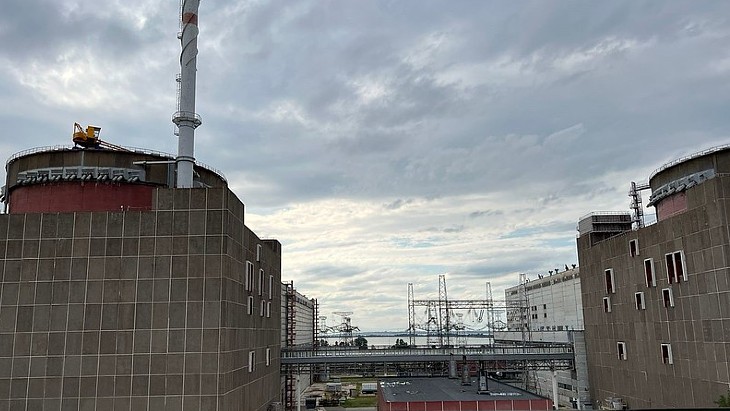The IAEA said that the six unit nuclear power plant, which has been under Russian military control since March 2022, lost all off-site power at 05:00 local time on Thursday when its last remaining 750 KV line was disconnected. The last remaining backup 330KV line is currently under repair after being damaged last week.
This was the sixth time that the plant had lost external power, but the first time since 23 November 2022.
There was a wave of Russian missile strikes on Ukrainian targets overnight, including the energy infrastructure, with nuclear operator Energoatom saying these had led to the loss of power. Russia said the loss of power was not caused by their actions, and said that power had been cut by the Ukraine side.
As on previous occasions, all of the site's emergency diesel generators were activated - there are now 20 of them - before some were turned off and by mid-morning eight of the generators were being used to provide the essential power needed for safety systems. The IAEA reports there is enough diesel on site for 15 days of operation.
The two reactors that were in hot shutdown - providing heat for the plant and the nearby town of Energodar where many of its workers live - were said to be moving into cold shutdown.
News that power supplies had been restored to the nuclear plant came in the early afternoon in Ukraine, with Ukrenergo saying on its Telegram channel its specialists had restored the power supply, with nuclear plant operator Energoatom adding Zaporizhzhia NPP was "once again feeding its own needs from the power system".
IAEA Director General Rafael Mariano Grossi reported the situation, during the loss of power, to the IAEA board of governors, who are meeting this week in Vienna. He said that emergency generators were the last line of defence, and this was the sixth time they have had to be relied upon: "Let me remind you - this is the largest nuclear power station in Europe. What are we doing? How can we sit here in this room this morning and allow this to happen? This cannot go on.
"I am astonished by the complacency - what are we doing to prevent this happening? We are the IAEA, we are meant to care about nuclear safety. Each time we are rolling a dice. And if we allow this to continue time after time then one day our luck will run out. I call on everyone in this room today and elsewhere - we must commit to protect the safety and security of the plant. And we need to commit now. What we need is action."
Grossi has spent months in talks with the two sides in the war about creating a protected zone at and around the Zaporizhzhia nuclear power plant, which is sited on the frontline of the war, with both sides blaming the other for shelling at and near it during the conflict. Although both sides agree in principle to a protection zone, the details have not been able to be agreed and public statements in recent days have not been encouraging but Grossi pledged to "continue my urgent consultation and contacts".
On Sunday, Ukraine's energy minister Herman Halushchenko told Ukrainian TV: "Currently, the situation has reached a dead end. Our position, which we voice on all international platforms, boils down to the fact that any negotiations regarding the ZNPP should be based on: firstly, the plant's demilitarisation, and secondly, the exit of Rosatom employees from the ZNPP. Thirdly, Ukrainian personnel should be given the opportunity to operate a nuclear facility calmly, without pressure."
In response to those comments, Russia's permanent representative to the Vienna-based international organisations, Mikhail Ulyanov, told Tass news agency "it should be stated that talks on this zone are losing momentum" and claimed that the Ukrainian side was "looking for pretexts that have nothing to do with the real state of affairs". Renat Karchaa, an advisor to the director general of Russian nuclear company Rosenergoatom, said Russia's support for the zone included a key condition of a moratorium on any artillery activities around the plant.
In normal times, Zaporizhzhia has four main 750 kV offsite power lines plus three 330 kV back-up lines, connected to a thermal power plant 3.5 km east of the reactors. Each reactor has three back-up diesel generators. According to WENRA - the Western European Nuclear Regulators Association - one generator is sufficient to maintain a reactor and its used fuel in a safe state. A further two 'bunkerised' diesel generators are present onsite.
The reason that power is needed even if the reactors are shut down includes safety functions such as cooling for the removal of decay heat produced by the shutdown reactors, and to maintain services such as systems control, lighting, communication and ventilation at the site.
The IAEA teams at the other, non-occupied nuclear power plants, reported that they are continuing to operate although South Ukraine NPP has reported some losses of power lines and Khmelnitsky and Rivne NPP "are managing power levels in accordance with grid requirements".





_47120.jpg)

_23621.jpg)






